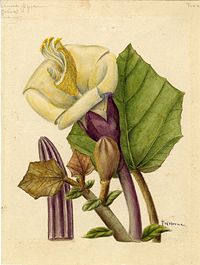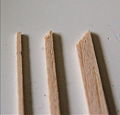Difference between revisions of "Balsa" - New World Encyclopedia
Rick Swarts (talk | contribs) |
Rick Swarts (talk | contribs) |
||
| Line 1: | Line 1: | ||
{{Ready}}{{Claimed}}{{Contracted}} | {{Ready}}{{Claimed}}{{Contracted}} | ||
| − | |||
{{Taxobox | {{Taxobox | ||
| color = orange | | color = orange | ||
| Line 19: | Line 18: | ||
}} | }} | ||
| − | '''Balsa''' is the common name for a fast-growing, tropical American tree, ''Ochroma pyramidale'', synonym ''O. lagopus''), characterized by soft and light wood. The name also is used for the wood of this species, which is commercially important and used for model building, life preservers and floats, and insulation, among other purposes. | + | '''Balsa''' is the common name for a fast-growing, tropical American tree, ''Ochroma pyramidale'', synonym ''O. lagopus''), characterized by soft and light wood. The name also is used for the wood of this species, which is commercially important, and despite being very soft, is classified as a [[hardwood]]—the softest commercial hardwood. |
| + | |||
| + | |||
| + | |||
| + | and used for model building, life preservers and floats, and insulation, among other purposes. | ||
==Overview== | ==Overview== | ||
| + | Balsa, ''Ochroma pyramidale'', has traditionally been classified in the Bombacaceae family. However, Bombacaceae is not not universally recognized as the rank of the family, and is sometimes treated as as a subfamily within the family Malvaceae. For example, Bombacaceae is not recognized by the [[Angiosperm Phylogeny Group]] I 1998, II 2003, and [[Kubitzki system]] 2003 at the rank of family, the bulk of the taxa in question being treated as subfamily Bombacoideae within family Malvaceae ''sensu lato''. A close relationship between Bombacaceae and Malvaceae has long been recognized but until recently the families have been kept separate in most classification systems, and continue to be separated in many references, including the newest reference work in classification of [[flowering plants]]: Heywood et al. 2007. Heywood et al. state "although closely related to Malvaceae, molecular data supports their separation." | ||
| + | |||
| + | Balsa is a large, fast-growing [[tree]] that can grow up to 30 meters tall. It is native to [[tropical]] [[South America]] as far north as southern [[Mexico]]. It is [[evergreen]], or dry-season [[deciduous]] if the dry season is long, with large (30 to 50 centimeter) weakly palmately lobed leaves. The flowers are large and whitish, yellowish, or brownish. | ||
| + | |||
| + | The [[timber]] is very soft and light with a coarse open grain. The [[density]] of dry balsa [[wood]] ranges from 100–200 kg/m³, with a typical density of about 140 kg/m³ (about one third the density of other kinds of hard wood). The tree must be keep free from adverse conditions and injury to maintain its commercial value, otherwise it can become heavier or harder in texture. | ||
| + | |||
| + | ==Uses== | ||
| + | Balsa wood is light, soft, and buoyant. It is even more light than cork and thus has long been used for lifebelts, and life preservers, and was famously used by [[Thor Heyerdahl]] in his raft [[Kon-Tiki]]. Indeed, the name ''balsa'' derives from [[Spanish language|Spanish]] for a [[raft]]. | ||
| + | |||
| + | This makes it a very popular material for [[model building]] | ||
| − | + | It is also a very popular material to use when making wooden [[crankbait]]s for fishing, as it is low density but high in strength. Balsa wood is used to make very light, stiff structures in [[balsa wood bridges|model bridge tests]] and for the construction of light wooden [[aeroplane]]s, most famously the [[World War II]] [[de Havilland Mosquito]]. It also is used in the [[floorpan]] of the [[Chevrolet Corvette|Chevrolet Corvette Z06]] sandwiched between two sheets of carbon fiber. In table tennis blades, a balsa layer is typically sandwiched between two pieces of thin [[plywood]].Balsa wood is also used for making high-quality [[balsa surfboards]].<ref>[http://www.balsasurfboardsriley.com/ Riley Classic Balsawood Surfboards], ''Riley Australia''. Retrieved October 24, 2007.</ref> | |
| − | |||
| − | |||
<gallery> | <gallery> | ||
| Line 42: | Line 53: | ||
==References== | ==References== | ||
{{Refimprove|date=October 2007}} | {{Refimprove|date=October 2007}} | ||
| + | |||
| + | <ref name = Heywood>{{cite book|author = Heywood, V. H., Brummitt, R. K., Culham, A. & Seberg, O. |title = Flowering Plant Families of the World|edition = | publisher = Firefly Books| year = 2007| location = Richmond Hill, Ontario, Canada|isbn = 1-55407-206-9}}</ref>. | ||
==External Links== | ==External Links== | ||
| Line 52: | Line 65: | ||
[[Category:Life sciences]] | [[Category:Life sciences]] | ||
| − | {{Credits|163540273}} | + | {{Credits|Balsa|163540273|Bombacaceae|167630602}} |
Revision as of 04:18, 17 December 2007
| Balsa | ||||||||||||||
|---|---|---|---|---|---|---|---|---|---|---|---|---|---|---|
 Painting by Frances W. Horne from the Flora Borinqueña
| ||||||||||||||
| Scientific classification | ||||||||||||||
| ||||||||||||||
| Ochroma pyramidale (Cav. ex Lam.) Urb. |
Balsa is the common name for a fast-growing, tropical American tree, Ochroma pyramidale, synonym O. lagopus), characterized by soft and light wood. The name also is used for the wood of this species, which is commercially important, and despite being very soft, is classified as a hardwood—the softest commercial hardwood.
and used for model building, life preservers and floats, and insulation, among other purposes.
Overview
Balsa, Ochroma pyramidale, has traditionally been classified in the Bombacaceae family. However, Bombacaceae is not not universally recognized as the rank of the family, and is sometimes treated as as a subfamily within the family Malvaceae. For example, Bombacaceae is not recognized by the Angiosperm Phylogeny Group I 1998, II 2003, and Kubitzki system 2003 at the rank of family, the bulk of the taxa in question being treated as subfamily Bombacoideae within family Malvaceae sensu lato. A close relationship between Bombacaceae and Malvaceae has long been recognized but until recently the families have been kept separate in most classification systems, and continue to be separated in many references, including the newest reference work in classification of flowering plants: Heywood et al. 2007. Heywood et al. state "although closely related to Malvaceae, molecular data supports their separation."
Balsa is a large, fast-growing tree that can grow up to 30 meters tall. It is native to tropical South America as far north as southern Mexico. It is evergreen, or dry-season deciduous if the dry season is long, with large (30 to 50 centimeter) weakly palmately lobed leaves. The flowers are large and whitish, yellowish, or brownish.
The timber is very soft and light with a coarse open grain. The density of dry balsa wood ranges from 100–200 kg/m³, with a typical density of about 140 kg/m³ (about one third the density of other kinds of hard wood). The tree must be keep free from adverse conditions and injury to maintain its commercial value, otherwise it can become heavier or harder in texture.
Uses
Balsa wood is light, soft, and buoyant. It is even more light than cork and thus has long been used for lifebelts, and life preservers, and was famously used by Thor Heyerdahl in his raft Kon-Tiki. Indeed, the name balsa derives from Spanish for a raft.
This makes it a very popular material for model building
It is also a very popular material to use when making wooden crankbaits for fishing, as it is low density but high in strength. Balsa wood is used to make very light, stiff structures in model bridge tests and for the construction of light wooden aeroplanes, most famously the World War II de Havilland Mosquito. It also is used in the floorpan of the Chevrolet Corvette Z06 sandwiched between two sheets of carbon fiber. In table tennis blades, a balsa layer is typically sandwiched between two pieces of thin plywood.Balsa wood is also used for making high-quality balsa surfboards.[1]
Notes
- ↑ Riley Classic Balsawood Surfboards, Riley Australia. Retrieved October 24, 2007.
ReferencesISBN links support NWE through referral fees
[1].
External Links
- Technical Description, History, Facts, Specs Retrieved October 12, 2007.
- Species description Retrieved October 12, 2007.
- Germplasm Resources Information Network: Ochroma pyramidale Retrieved October 12, 2007.
- Photo of foliage and flower Retrieved October 12, 2007.
- Kon-Tiki museum website Retrieved October 12, 2007.
- Balsa rafting in Ecuador Retrieved October 12, 2007.
Credits
New World Encyclopedia writers and editors rewrote and completed the Wikipedia article in accordance with New World Encyclopedia standards. This article abides by terms of the Creative Commons CC-by-sa 3.0 License (CC-by-sa), which may be used and disseminated with proper attribution. Credit is due under the terms of this license that can reference both the New World Encyclopedia contributors and the selfless volunteer contributors of the Wikimedia Foundation. To cite this article click here for a list of acceptable citing formats.The history of earlier contributions by wikipedians is accessible to researchers here:
The history of this article since it was imported to New World Encyclopedia:
Note: Some restrictions may apply to use of individual images which are separately licensed.
- ↑ Heywood, V. H., Brummitt, R. K., Culham, A. & Seberg, O. (2007). Flowering Plant Families of the World. Richmond Hill, Ontario, Canada: Firefly Books. ISBN 1-55407-206-9.

